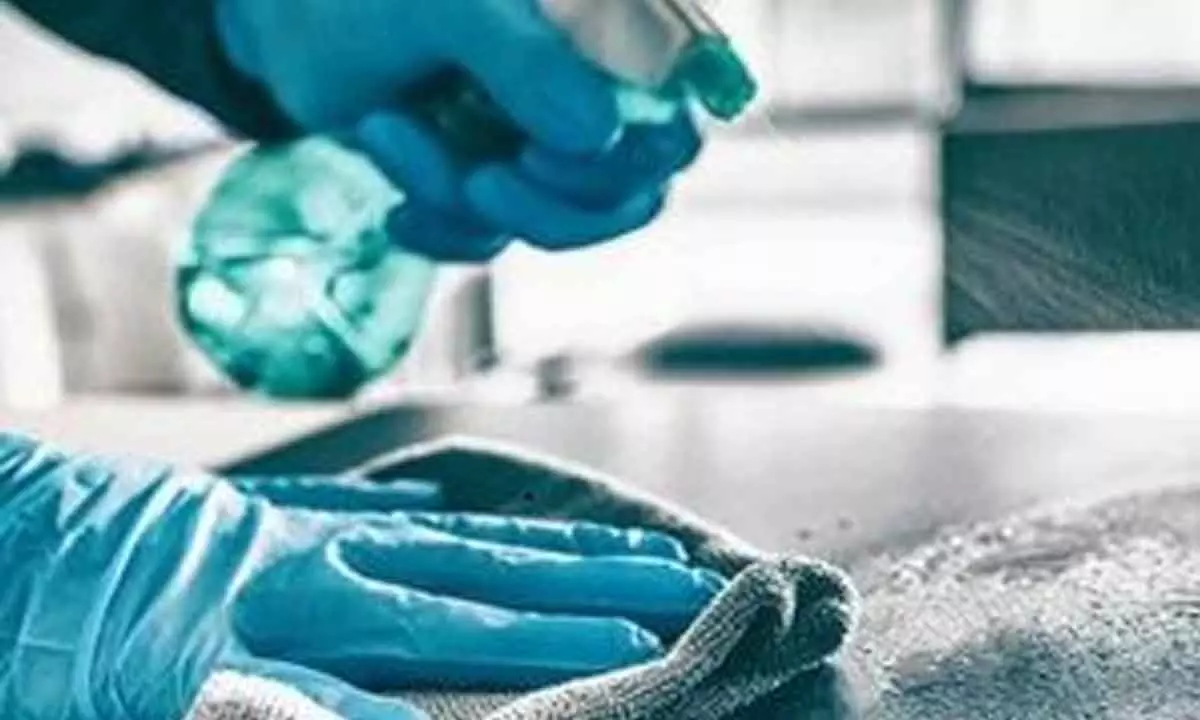Live
- First Star Outside Milky Way Captured: WOH G64 is 2,000 Times Larger Than the Sun
- Sikkim govt to constitute state Niti Ayog: CM Tamang
- CBI books Rajasthan narcotics inspector for Rs 3 lakh bribe
- Rajasthan bypolls: A tough contest between BJP and Congress
- Albania joins SEPA, paving way for EU integration
- Japanese government approves 250-billion USD economic package to ease price pain
- Six pharma companies to set up their units in Telangana
- The Unstable Events of a 17-Wicket Day in Perth: India vs Australia
- Dutch FM's Israel trip cancelled after Netanyahu's arrest warrant
- UK to increase energy price cap by 1.2 per cent
Just In

Researchers focused on high-touch surfaces such as simulation manikins used for resuscitation practice, workstations on wheels, breakroom tables, bed rails, and computer keyboards at nurse’s stations. All of these surfaces were found to harbour bacteria, and manikins and bed rails also had the most diverse types of bacteria
New York: Despite compliance with recommended disinfection protocols, high-touch hospital surfaces, bed rails, workstations, and other frequently-touched surfaces contain microbial contamination, including harmful pathogens, according to a study. The findings, published today in the American Journal of Infection Control (AJIC), shed light on the persistent challenge of reducing healthcare-associated infections (HAIs) and indicate that innovative strategies may be needed for more effective disinfection of these surfaces.
The study was conducted at the Central Texas Veterans Healthcare System, where researchers collected samples from 400 surfaces between June and July of 2022. They focused on high-touch surfaces such as simulation manikins used for resuscitation practice, workstations on wheels, breakroom tables, bed rails, and computer keyboards at nurse’s stations. All of these surfaces were found to harbour bacteria, and manikins and bed rails also had the most diverse types of bacteria.
A total of 60 different kinds of bacteria were identified across all samples, including 18 well-known human pathogens and a number of bacteria that can be pathogenic to humans under certain circumstances. The most common types of known pathogenic bacteria included Enterococcus, Staphylococcus aureus, Streptococcus, Escherichia coli, and Klebsiella aerogenes, among others.
Some of the potentially pathogenic types of bacteria have been associated with central-line associated bloodstream infections, meningitis, and endocarditis. About half of the bacteria identified through these samples were also found in clinical samples collected from patients during 2022. “It is a continuing frustration to healthcare professionals that HAIs persist despite rigorous attention to disinfection practices,” said Piyali Chatterjee, Research Scientist at Central Texas Veterans Healthcare System.
“Our study clearly shows the bioburden associated with high-touch hospital surfaces -- including simulation manikins, which are not typically regarded as a risk because patients rarely touch them -- and indicates that we must do better in protecting the health of our patients and our hospital employees,” she added. The new study demonstrates, current best practices in routine hospital disinfection may not be sufficient to prevent the spread of pathogens, particularly for surfaces that are frequently touched by many different people.
When discussing C&D (Cleaning & Disinfection), it is important to recognize there are different processes that can be used to destroy microorganisms. These terms are often used interchangeably, but their level of destruction varies. Cleaning involves the physical removal of visible contamination from surfaces. Soaps and detergents bind to oils, soil and organic material so it can be rinsed away. Some cleaners can disrupt the lipid components (e.g., cell membrane or viral envelope) of certain pathogens.
Sanitizing significantly reduces bacterial contamination on surfaces to levels considered safe from a public health standpoint. It does not eliminate all microorganisms. Sanitizers are most commonly used for food contact surfaces.
Disinfection destroys or irreversibly inactivates most pathogens (e.g., bacteria, viruses and fungi) on surfaces (i.e., inanimate objects). It is generally not effective against bacterial spores. Efficacy will vary with disinfectant product or method. Sterilization destroys or eliminates all forms of microbial life, including bacterial spores. This involves the use of higher levels of physical (e.g., extreme heat) or chemical (liquid or gas sterilants) processes and is generally used for medical devices/equipment. Antiseptics are products applied to the surface of living organisms or tissues (e.g., skin) to destroy or inhibit the growth of microorganism.
All lumens and channels of endoscopic instruments must contact the disinfectant. Air pockets interfere with the disinfection process, and items that float on the disinfectant will not be disinfected. The disinfectant must be introduced reliably into the internal channels of the device. The exact times for disinfecting medical items are somewhat elusive because of the effect of the aforementioned factors on disinfection efficacy. Certain contact times have proved reliable. Items must be exposed to the germicide for the appropriate minimum contact time. Multiple investigators have demonstrated the effectiveness of low-level disinfectants against vegetative bacteria (e.g., Listeria, E. coli, Salmonella, VRE, MRSA), yeasts (e.g., Candida), mycobacteria (e.g., M. tuberculosis), and viruses (e.g., poliovirus) at exposure times of 30–60 seconds 46-64. By law, all applicable label instructions on EPA-registered products must be followed.
Improved hydrogen peroxide-based liquid surface disinfectants and a combination product containing peracetic acid and hydrogen peroxide are effective alternatives to disinfectants currently in widespread use, and electrolyzed water (hypochlorous acid) and cold atmospheric pressure plasma show potential for use in hospitals. Creating “self-disinfecting” surfaces by coating medical equipment with metals such as copper or silver, or applying liquid compounds that have persistent antimicrobial activity surfaces are additional strategies that require further investigation, says an abstract at https://aricjournal.biomedcentral.com.

© 2024 Hyderabad Media House Limited/The Hans India. All rights reserved. Powered by hocalwire.com







